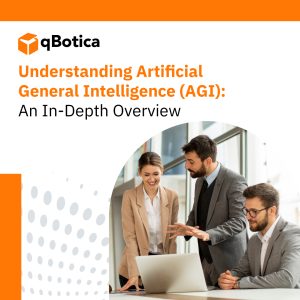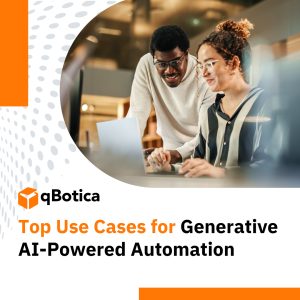In the Web 3.0 digital world, paper documentation management is extraordinarily costly and error-prone. Such manual procedures are also antiquated, keeping modern organizations stuck in the past. But most businesses want to move into the future. They want to automate time-consuming operations. They just need the technology to get started.
Fortunately, optical character recognition (OCR)technology makes it simple to convert printed or handwritten text and images into digital, machine-encoded formats. And that’s just the beginning. When businesses combine OCR technology with robotic process automation(RPA) software and artificial intelligence (AI), they can experience even more significant benefits.
So, what is optical character recognition, and how can businesses get the most value from this technology to automate operations?
What is optical character recognition (OCR)?
OCR converts text from scanned documents, PDFs, and images into editable documents. For example, thisfascinating computer process can take the image of a word, such as “pier,” and separate the letters into four distinct parts—P, I, E, and R–as if you were typing them on a keyboard. The system then allows you to edit those letters, such as rearranging them or deleting them, without affecting the rest of the document, just as you might while editing an email or any other document in electronic form.
Businesses in any sector, from banking and finance to healthcare, legal, and more, can use OCR to scan almost any document or image, including:
- Paper invoices
- Tax documents
- Payroll information
- Contracts and complex legal documents
- Handwritten contact information
- Business cards
- Text inside charts and images
Today’s OCR solutions can recognize and capture data from machine-printed documents and even decipher handwritten text with high levels of speed and accuracy, saving workers hours of valuable time so they can focus on more pertinent tasks.
How does OCR benefit business operations?
OCR has numerous benefits, and businesses can use it to:
- Automate data entry and minimize errors: Even in today’s digital world, the average office worker still goes through almost 10,000 pieces of paper a year, wasting significant resources. OCR digitizes paperwork while minimizing human interaction, saving time, reducing transcription mistakes, and increasing data integrity.
- Edit documents: Traditional scanners can only export documents, forms, and invoices as images or PDFs that are not in an editable format. However, OCR makes it possible to scan a contract and export the text to an editing program, such as Microsoft Word or Google Docs.
- Organize and easily access documents: OCR can automatically sort through various piles of papersand organize them according to specific rules, such as by type or vendor. It also makes files instantly accessible and usable for all authorized users.
- Increase storage space: Offices running out of storage space or drowning in paper files can eliminate space-hogging file cabinets and expensive leases on rented storage facilities by going fully digital.
- Understand text over interfaces: Using OCR technology, isolated teams can easily collaborate, making it faster and easier to process data over remote interfaces, such as cloud servers.
What are some limitations of OCR?
While optical character recognition is a powerful tool, it does have a few limitations when used as a standalone technology:
- Understanding data: OCR digitizes text from documents and makes it machine-readable, but it can’t understand or interpret that data without complementary programming.
- Putting words in context: An OCR system doesn’t have AI intelligence built-in, so it might transcribe a word incorrectly, such as “bail” when the actualword is “ball.” While highly efficient, OCR by itself lacks the cognitive ability to incorporate the sentence’s context to determine the correct word with 100% accuracy.
- Separating documents: OCR can export data from documents, but it has issues breaking down groups of files into separate documents or separating the information into categories based on the standard form fields. For that, OCRneeds help from robotic process automation (RPA) software.
Combining RPA and OCR for Better Results
Robotic process automation (RPA)softwarecaptures data and manipulates applications with precision.In fact,90% of large organizationshave already adopted RPA, and document managementis one of the key reasons.
RPA software can automatically process invoices, onboard new employees, file insurance information, and manage order forms, to name a few. But towork,RPA needs support from optical character recognition technology(OCR).
Simply put: OCR can digitize documents. RPA software can process them. Both do essentialjobs, but they rely on each other for the best business results.
OCR digitizes data so RPA technology can analyze it
RPA can only process documents if they contain structured data, where the information is already digitized, and the layout is consistent and easily searchable. Unfortunately, most business data today is unstructured—or non-digital—in places like printed documents, audio files, images, PDFs, and logs. Fortunately, businesses can use OCR to extract data from various sources and instantaneously turn them into structured digital formats, allowing RPA systems to efficiently analyze information and automate tasks.
OCR enables more complex automation capabilities.
Once the OCR engine digitizesdocuments into readable data, RPA can process and perform actions based on its content, such as scanning sales figures or completing tax forms. Once OCR digitizes the content, an RPA bot can read the information, recognize its context, and send it to the corresponding department or manager for review. It can even flag suspicious details, such as potential fraud or names on forms that don’t match the submitted ID.
OCR, RPA, and AI: The future of advanced document processing
OCR combined with RPA effectively digitizes and analyzes documents using rule-based tasks. But some businesses seek even more functionality by integrating machine learning (ML) and artificial intelligence (AI) into the fold.
AI and ML are dynamic technologies that almost mimic the human brain to learn and adapt to new information over time. As such, they can handle more complex assignments with speed and precision. For example, when combined with RPA bots and optical character recognition, AI-powered intelligent document processing (IDP) software can read unstructured data, capture information, and convert it into formats for government, banking, insurance, orders, invoices, and loan processing. Critically, it can also learn from each document it processes to optimize speed and efficiency continually.
———————————
OCR is an essentialtoolto help move businesses into the paperless future, reducing and often eliminating the manual labor required for many office tasks. When combined with RPA and AI, OCRalso delivers high-quality structured data that enables bots to automate more tasks, saving time and money while freeing workers to take on more important responsibilities.
At qBotica, we specialize in improving business workflows through advanced automation tools. If your company wants to learn how to get started in intelligent document automation or would like to expand its current system, schedule a discovery call today to speak with an automation expert.




